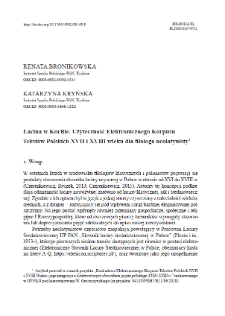- Search in all Repository
- Literature and maps
- Archeology
- Mills database
- Natural sciences
Advanced search
Advanced search
Advanced search
Advanced search
Advanced search

Object
Title: Latin in KorBa. Usefulness of the Electronic Corpus of 17th- and 18th-century Polish Texts fora Neo-Latinist philologist
Publisher:
Instytut Języka Polskiego Polskiej Akademii Nauk
Place of publishing:
Abstract:
The article presents the Electronic Corpus of 17th- and 18th-century Polish Texts (informally called KorBa)in terms of its usefulness for neo-Latinist research. The corpus contains approximately 0.5 million tokensannotated as Latin words, which makes them easy to find by means of the corpus search engine. The articledescribes examples of research that can be carried out on the material collected in the corpus, both on individualLatin phrases and on the mutual relations between the Polish language and Latin in Middle Polishtexts. Some data taken from the frequency list of Latin word forms in the corpus were also presented.
References:
Czerenkiewicz, M. (2015). Czy potrzeba nam dzisiaj polskiego słownika łaciny renesansowej i barokowej? Polonica, 35, s. 39–47.
Czerenkiewicz, M., Ryczek, W. (2013). Studia (neo)latina rediviva. Kilka uwag i postulatów odnośnie neolaty-nistyki. Terminus, T. 15, 3(28), s. 335–358. Pobrane z https://doi.org/10.4467/20843844TE.13.021.1578 (4.08.2020).
Gruszczyński, W., Adamiec, D., Bronikowska, R., Wieczorek, A. (2020). Elektroniczny Korpus Tekstów Polskich z XVII i XVIII w. – problemy teoretyczne i warsztatowe. Poradnik Językowy, 8, s. 32–51.
Nowak, K. (2014). Fontes Mediae et Infimae Latinitatis Polonorum. Z prac nad korpusem polskiej łaciny średniowiecznej. Polonica, 34, s. 105–114.
Ogrodniczuk, M., Gruszczyński, W. (2019). Connecting Data for Digital Libraries: The Library, the Dictionary and the Corpus. W: A. Jatowt, A. Maeda, S. Yeon Syn (eds.), Digital Libraries at the Crossroads of Digital Information for the Future. ICADL 2019. Lecture Notes in Computer Science, 11853, s. 125–138. Pobrane z https://doi.org/10.1007/978-3-030-34058-2_13 (2.12.2019).
Plezia, M., Weyssenhoff-Brożkowa, K., Rzepiela, M. (red.) (1953–). Słownik łaciny średniowiecznej w Polsce. Wrocław–Kraków: Zakład Narodowy im. Ossolińskich – Wydawnictwo Polskiej Akademii Nauk.
Skolimowska, A., Kunicki-Goldfinger, M. (2004). Łacina w polskojęzycznych diariuszach podróży. W: J. Axer (red.), Łacina jako język elit (s. 189–220). Warszawa: Wydawnictwo DiG.
Sondel, J. (1997). Słownik łacińsko-polski dla prawników i historyków. Kraków: Universitas.
Relation:
Volume:
Start page:
End page:
Detailed Resource Type:
Format:
Resource Identifier:
10.17651/POLON.40.8 ; oai:rcin.org.pl:162562
Language:
Language of abstract:
Rights:
Terms of use:
Copyright-protected material. May be used within the limits of statutory user freedoms
Access:
Object collections:
- Digital Repository of Scientific Institutes > Partners' collections > Institute of Polish Language PAS
- Digital Repository of Scientific Institutes > Partners' collections > Institute of Polish Language PAS > Serials
- Digital Repository of Scientific Institutes > Partners' collections > Institute of Polish Language PAS > Filds of science > Humanities > Linguistics
- Digital Repository of Scientific Institutes > Partners' collections > Institute of Polish Language PAS > Filds of science > Humanities > Linguistics > Modern Polish Language
- Digital Repository of Scientific Institutes > Partners' collections > Institute of Polish Language PAS > Offprint
- Digital Repository of Scientific Institutes > Literature
- Digital Repository of Scientific Institutes > Literature > Journals/Articles
Last modified:
Feb 19, 2021
In our library since:
Feb 19, 2021
Number of object content downloads / hits:
511
All available object's versions:
https://rcin.org.pl./publication/196753
Show description in RDF format:
Show description in RDFa format:
Show description in OAI-PMH format:
| Edition name | Date |
|---|---|
| Łacina w KorBie. Użyteczność Elektronicznego KorpusuTekstów Polskich XVII i XVIII wieku dla filologa neolatynisty | Feb 19, 2021 |

 INSTYTUT ARCHEOLOGII I ETNOLOGII POLSKIEJ AKADEMII NAUK
INSTYTUT ARCHEOLOGII I ETNOLOGII POLSKIEJ AKADEMII NAUK
 INSTYTUT BADAŃ LITERACKICH POLSKIEJ AKADEMII NAUK
INSTYTUT BADAŃ LITERACKICH POLSKIEJ AKADEMII NAUK
 INSTYTUT BADAWCZY LEŚNICTWA
INSTYTUT BADAWCZY LEŚNICTWA
 INSTYTUT BIOLOGII DOŚWIADCZALNEJ IM. MARCELEGO NENCKIEGO POLSKIEJ AKADEMII NAUK
INSTYTUT BIOLOGII DOŚWIADCZALNEJ IM. MARCELEGO NENCKIEGO POLSKIEJ AKADEMII NAUK
 INSTYTUT BIOLOGII SSAKÓW POLSKIEJ AKADEMII NAUK
INSTYTUT BIOLOGII SSAKÓW POLSKIEJ AKADEMII NAUK
 INSTYTUT CHEMII FIZYCZNEJ PAN
INSTYTUT CHEMII FIZYCZNEJ PAN
 INSTYTUT CHEMII ORGANICZNEJ PAN
INSTYTUT CHEMII ORGANICZNEJ PAN
 INSTYTUT FILOZOFII I SOCJOLOGII PAN
INSTYTUT FILOZOFII I SOCJOLOGII PAN
 INSTYTUT GEOGRAFII I PRZESTRZENNEGO ZAGOSPODAROWANIA PAN
INSTYTUT GEOGRAFII I PRZESTRZENNEGO ZAGOSPODAROWANIA PAN
 INSTYTUT HISTORII im. TADEUSZA MANTEUFFLA POLSKIEJ AKADEMII NAUK
INSTYTUT HISTORII im. TADEUSZA MANTEUFFLA POLSKIEJ AKADEMII NAUK
 INSTYTUT JĘZYKA POLSKIEGO POLSKIEJ AKADEMII NAUK
INSTYTUT JĘZYKA POLSKIEGO POLSKIEJ AKADEMII NAUK
 INSTYTUT MATEMATYCZNY PAN
INSTYTUT MATEMATYCZNY PAN
 INSTYTUT MEDYCYNY DOŚWIADCZALNEJ I KLINICZNEJ IM.MIROSŁAWA MOSSAKOWSKIEGO POLSKIEJ AKADEMII NAUK
INSTYTUT MEDYCYNY DOŚWIADCZALNEJ I KLINICZNEJ IM.MIROSŁAWA MOSSAKOWSKIEGO POLSKIEJ AKADEMII NAUK
 INSTYTUT PODSTAWOWYCH PROBLEMÓW TECHNIKI PAN
INSTYTUT PODSTAWOWYCH PROBLEMÓW TECHNIKI PAN
 INSTYTUT SLAWISTYKI PAN
INSTYTUT SLAWISTYKI PAN
 SIEĆ BADAWCZA ŁUKASIEWICZ - INSTYTUT TECHNOLOGII MATERIAŁÓW ELEKTRONICZNYCH
SIEĆ BADAWCZA ŁUKASIEWICZ - INSTYTUT TECHNOLOGII MATERIAŁÓW ELEKTRONICZNYCH
 MUZEUM I INSTYTUT ZOOLOGII POLSKIEJ AKADEMII NAUK
MUZEUM I INSTYTUT ZOOLOGII POLSKIEJ AKADEMII NAUK
 INSTYTUT BADAŃ SYSTEMOWYCH PAN
INSTYTUT BADAŃ SYSTEMOWYCH PAN
 INSTYTUT BOTANIKI IM. WŁADYSŁAWA SZAFERA POLSKIEJ AKADEMII NAUK
INSTYTUT BOTANIKI IM. WŁADYSŁAWA SZAFERA POLSKIEJ AKADEMII NAUK


































